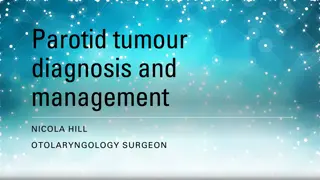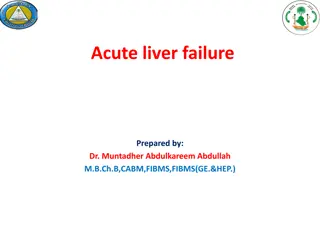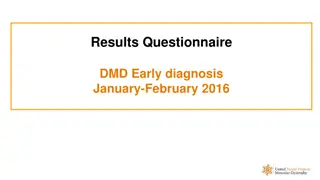Overview of Infective Endocarditis: Etiology, Presentation, Diagnosis, and Management
Infective endocarditis is an infection of the heart's endocardial surface that can be classified into four groups. It is crucial to recognize common bacteria causing IE, understand clinical presentations, diagnostic methods, and management strategies. The pathophysiology involves turbulent blood flow leading to bacterial adherence to the endocardium. The disease predominantly affects the elderly population, with a changing incidence due to factors like rheumatic heart disease decline and aging demographics.
Download Presentation

Please find below an Image/Link to download the presentation.
The content on the website is provided AS IS for your information and personal use only. It may not be sold, licensed, or shared on other websites without obtaining consent from the author.If you encounter any issues during the download, it is possible that the publisher has removed the file from their server.
You are allowed to download the files provided on this website for personal or commercial use, subject to the condition that they are used lawfully. All files are the property of their respective owners.
The content on the website is provided AS IS for your information and personal use only. It may not be sold, licensed, or shared on other websites without obtaining consent from the author.
E N D
Presentation Transcript
Infective Endocarditis ALI SOMILY,MD,FRCP(C) ali.somily@gmail.com FAWZIA ALOTAIBI, MD ofawzia@ksu.edu.sa
Objectives Define infective endocarditis Recognize the bacteria such as staphylococcus aureus and streptococcus viridans as the most common etiologies of IE Know the different clinical presentation of acute and sub-acute IE To recognize the different clinical presentation of IE; fever as the most common cause of pyerixia of unknown origin (P.U.O). TO the bacterial and host factors affecting the severity and outcome of the disease. Recognize the sources of bacteria causing bacteremia preceding IE. To know the pathogenesis of IE and the formation and importance of vegetations. To know the predisposing factors such as RHD, CHD, prosthetic valves and IVDU. To the common bacterial causes of IE associated with different sources and clinical conditions. To realize the infection as a diagnostic challenge and to know the different diagnostic methods of IE including; Clinical presentation (signs & symptoms) 1. Laboratory tests mainly multiple blood cultures. 2. Echocardiogram for the presence of vegetations 3. To know the different regimens used to treat different types of organisms. To know possible complications of IE.
Outlines Definition Pathogenesis Riskfactors Clinical presentation Diagnosis Culture negativeendocarditis Management Prophylaxis
Definition Infectious Endocarditis (IE): an infectionof the heart s endocardialsurface Classified into fourgroups: Native ValveIE Prosthetic ValveIE Intravenous drug abuse(IVDA) IE Nosocomial IE
Further Classification Acute: Affectsnormal heart valves Subacute: Often affects damaged heart valves Rapidlydestructive If not treated, usually fatalwithin 6weeks Commonly Staph Metastatic foci Indolent nature If not treated, usually fatal byone year Commonly viridans Streptococci
Pathophysiology 1. Turbulent blood flow disruptsthe endocardium making it sticky 2. Bacteremia delivers theorganisms to the endocardialsurface 3. Adherence of the organisms to the endocardial surface 4. Eventual invasion of thevalvular leaflets
Epidemiology Incidence: 1.7 6.2 / 100, 000 person years M:F1.7 Becoming a disease of theelderly Median age PreABx era 35y Now 58y Due to twofactors The decline of rheumatic heart disease The increasing proportion ofelderly
Prosthetic Valve 7 -25 % of cases of infectiveendocarditis Early <12mons Late >12mons 0.94 per 100,000bioprosthetic Initially mechanical valves at greater risk for first 3mo, then risk same at 5y 1-3.1% risk at 1yr 2-5.7% at 5yr
Risk Factors Injection drug use 100X risk inyoung Staphylococcusaureus Other risks: Poor dentalhygiene Hemodialysis DM HIV IVDU Rates 150-2000/ 100000 person years Higher among patientswith known valvular heart disease Structural cardiac abnormality 75% of pts will have a preexisting structural cardiac abnormality 10-20% have congenital heart disease 1. 2. 3. 4.
Risk Factors ; Cardiac Abnormality High risk Moderate risk MVP w/ MR/thickened leaflets- 5 to 8 times (100/100 000 person years) Previous IE 4.5(2.5 to 9)% Aortic valve disease12 to30% Rheumaticvalve disease Prosthetic valve Coarctation Complexcyanotic congenital MitralStenosis tricuspidvalve Pulmonary Stenosis Hypertrophic Obstructive Cardiomyopathy (HOCM) Low/no risk ASD(secundum) CABG
Risk Factors HIVinfection: Anumber of cases of IEhave been reported in patients with HIVinfection It has been suggested that HIVinfection is an independent risk factor for IE inIDU Rheumatic valve disease: Predisposition for young in some countries 37%-76%ofcases Mitral 85%, Aortic50% Degenerative valvularlesions MVProlapse and associated mitral regurgitation - 5to 8times higher IErisk Aortic valve disease (stenosis or/and regurgitation) is present in 12 to 30 % ofcases
Diagnostic approach History of prior cardiaclesions A recent source ofbacteremia
Symptoms Acute High grade feverand chills SOB Arthralgias/ myalgias Abdominal pain Pleuritic chest pain Backpain Subacute Low grade fever Anorexia Weight loss Fatigue Arthralgias/ myalgias Abdominal pain N/V The onset of symptoms is usually ~2weeks or less from the initiatingbacteremia
Physical examination Signs Fever Heart murmur Nonspecific signs petechiae, subungal or splinter hemorrhages, clubbing, splenomegaly, neurologic changes More specific signs - Osler s Nodes, Janeway lesions, and RothSpots Look for small andlarge emboli with special attention to the fundi, conjunctivae, skin, and digits Cardiac examinationmay reveal signs of new regurgitation murmurs and signs ofCHF Neurologic evaluation may detect evidenceof focal neurologic impairment
Other aspects clinical diagnosis WHICH V ALVE? R or L heart where would emboli go? HEARTFUNCTION? Pump, acute valve dysfunctionconduction Look for evidence emboli Bleed (intracranial, elsewheremycotic aneurysm )
Diagnostic approach 1 Positive blood cultureresults Aminimum of three blood cultures should be obtained over a time period based upon the severity of theillness 2 Additional laboratory Nonspecifictest An elevated ESR and/or anelevated level of CRP is usually present Most patients quickly develop a normochromic normocytic anemia The WBCcount may be normal or elevated
Additional laboratory tests abnormalurinalysis The combination of RBC casts on urinalysis and a low serum complement level may be an indicator of immune-mediated glomerular disease ECG: New A V , fascicular, or bundle branchblock... .?PERIV ALVULAR INVAVSION monitoring, ??pacing
Prosthetic Valve IE Early (0-2 mo) 1 -3.1% 50% Staphylococci S. epi.> S. aureus, gnb, enterococci Late (>12 mo) 2 -5.7% IE in IV drug abusers Native Valve IE Strep. (55%), mostly S. viridans Staph. (30%), mostly S. aureus Enterococci (5-10%), GNB=HACEK(5%), Fungi Staph.aureus(50-60%)
Case Definition: IE Dukecriteria In 1994 investigators from DukeUniversity modified the previous criteria to include The role of echocardiography in diagnosis They also expanded the category of predisposing heart conditions to include intravenous drug use
Modified Duke criteria Possible IE 2major 1 major and 3minor 5minor Rejected IE Resolution of illness withfour days or less ofantibiotics Proposed: 2000,Addresses TEE, Broad possible categories. S. aureus risks (13-25% S. aureus bacteremia haveIE ) Definite IE Microorganism (via cultureor histology) in avalvular vegetation, embolized vegetation, orintracardiac abscess Histologic evidence ofvegetation or intracardiac abscess
Major criteria 1.MICROBIOLOGY Minor criteria Predisposition (heart conditionor IV drug use) Typical organism from2 separate culturesOR Microorganism from persistently positive BC OR Single BC + for Coxiella burnetii, or titer>1:800 2.ENDOCARDIALINVOLVEMEMT New (not changed) murmurof regurgitation 3.POSITIVEECHO (TEEif prosthetic valve, complicated, or pretest probability possibleIE 1.Fever >/=38oC 2.Vascular phenomenon(excludes petechiae, splinter hemorrhage) 3.major arterial emboli, Mycotic aneurysm, intracranial orconjunctival hemorrhages. Janeway lesions 4.Immunologic phenomena RF,.Roth s spots glomerulonephritis, Osler s nodes 6.Microbiologicevidence Not meeting major criteria single BC not CNS,serology
Petechiae 1. Nonspecific 2. Often located onextremities or mucousmembranes Harden Libraryfor the Health Sciences Photo credit, Josh Fierer,M.D.
Splinter Hemorrhages 1. Nonspecific 2. Nonblanching 3. Linear reddish-brown lesions found under the nail bed 4. Usuallydo NOTextend the entire length of the nail
Oslers Nodes American College ofRheumatology 1. More specific 2. Painful and erythematousnodules 3. Locatedon pulp of fingers and toes 4. More common in subacuteIE
Janeway Lesions 1. More specific 2. Erythematous, blanchingmacules 3. Nonpainful 4. Located on palms andsoles
Complications Four etiologies Embolic Local spread ofinfection Metastatic spread ofinfection Formation of immune complexes glomerulonephritis and arthritis
Embolic Complications Stroke MyocardialInfarction Fragments ofvalvular vegetation or vegetation-induced stenosis of coronary ostia Ischemic limbs Hypoxia frompulmonary emboli Abdominal pain(splenic or renalinfarction) Occur in up to40% of patients withIE Predictors ofembolization Size ofvegetation Left-sided vegetations Fungal pathogens, S.aureus, and Strep.Bovis Incidence decreases significantly after initiation ofeffective antibiotics
Septic Pulmonary Emboli Septic Retinalembolus http://www.emedicine.com/emerg/topic164.htm
Local Spread of Infection Heart failure Extensive valvular damage Paravalvular abscess(30-40%) Most common in aortic valve, IVDU, andS. aureus May extend into adjacent conduction tissue causing arrythmias Higher rates of embolization and mortality Pericarditis Fistulous intracardiac connections
Local Spread of Infection Acute S. aureus IE with perforation of the aortic valve and aortic valve vegetations. Acute S. aureus IE with mitral valve ring abscess extending intomyocardium.
Metastatic Spread of Infection Metastatic abscess Kidneys, spleen, brain, softtissues Meningitis and/or encephalitis Vertebral osteomyelitis Septic arthritis
Poor Prognostic Factors Female S.aureus Vegetation size Aortic valve Prosthetic valve Older age Diabetes mellitus Low serum albumen Apache IIscore Heart failure Paravalvular abscess Embolic events
Echocardiographic findings 1. Oscillating intracardiac mass o On valve or supportingstructure, In the path of regurgitation jets, Onimplanted material, in the absence of an altenate anatomicexplanation 3. abscess 1. New partial dehiscence of prostheticvalve 2. New valvular regurgitation (increaseor change in pre-existing murmur not sufficient)
Improved diagnostic value of echocardiography in patients with infective endocarditis by transoesophageal approachA prospective study Eur Heart J, 1988 Jan;9(i):43.5396 patients werestudied consecutively with TEE andTTE TEE sensitivity 100 percent for vegetationsas compared to 63percent with TTE Both TTE and TEE had specificity of98% 25% of vegetations less than 5mm, 69% of vegetations 6-10 mm, and 100%of vegetations greater than 11 mm detected by TEE were also observed withTTE
Culture Negative IE Hemophilus paraphrophilus, aphrophilus. Parainfluenzae Aggregatibacter(Actino b acillus) actinomycetemcomitans Cardiobacterium hominis Eikenella corrodens Kingellaspp. How hard didyou look? (50% culture negare d/t previous antibiotics) HACEK: - 2-3 wk incubation, subculturing, Tend to seesubacute w/ valve destruction/CHF
Lab Diagnosis! EtiologiesCulture Negative IE Based on clinical setting PCR ofvegetation/emboli: Tropheryma whippelei, bartonella Histology/stain /culture ofvegetation/emboli: Fungus Prolonged, enriched cultures: HACEK Lysis centrifugation system (Isolator): Bartonella, legionella (BCYE),fungal Serology: Endemic fungi, bartonella, Q fever, brucella, legionella,chiamydia Thioglycolate or cysteine supplementedmedia. S.aureus satellitism: Abiotrophia(NVS)
endocarditis GENERALCONSIDERA TIONS Antimicrobial therapy should be administered in a dose designed to give sustained bactericidal serum concentrations throughout much or all of the dosinginterval. In vitro determination of the minimum inhibitory concentration of the etiologiccause of the endocarditis should be performed in all patients.
The duration of therapy has to be sufficient to eradicatemicroorganisms growing within the valvular vegetations. The need for prolonged therapy in treating endocarditis hasstimulated interest in using combination therapy to treatendocarditis.
Indications for surgery in IE Combined therapy generally advisedwith Refractory CHF (mortality 56-86% w/o surgery vs 11-35%w/surgery) Perivalvualr invasivedisease Uncontrolled infection on maximalmedical therapy Recurrent systemic emboli, particularly in the presence of largevegetations SOME pathogens: Pseudomonas, brucella, coxiella, fungi,enterococci
Prosthetic same as native valve endocarditis Perivalvular infectionvalve Dehiscence Excessively mobile prosthesis onecho results in hemodynamicinstability
Prosthetic valve endocarditis that one may attemptmedical treatment alone: 1. >l2mo post surgical 2. VGS or HACEK or enterococci 3. No perivalvular extension Recurrence after surgery about7% / 6years Relapse, S. aureus usually meanssurgery S. aureus-RR death 0.18 in surgery plus AB vs ABxalone
VGS, NVS, sreptococcus MIC(ug/mI) Native valve prosthetic valve PenG or Ceph3 4wk PenG 6wkplus Gent 2wk <0.1 PenG 6wkPlus Gent 4wk >0.1 0.5 PenG 4wk plus Gent 2wk >0.5 PenG or Amp plus Gent for 4-6 wk total 6 wk Cloxacillin / Vancomycin 4-6 wk +/- gent X3-5d cloxacillin / vancomycin 6wk, gentamicin 2wk, rifampin 6 wk MSSA/ MRSA: Most common org IDU w/ R sided IE Clox plus gent 2wk, (not if complicated or febrile >lwk, large vegetations) HACEK Ceph3 for 4wk 6wk Aminoglycoside and flouroquinolones(or B-Lactam) Bartonella Doxycycline +or-hydroxychloroquine 26 months untill the titer below1:400 Q-fever 35% surgical
Prophylaxis Timing One hour priorto procedure: For High or Mod. cardiac risk conditions (previous list) For Dental, rigid bronchoscopy, esophageal procedures,G I mucosal procedures, cystoscopy, prostate surgery Antibiotic Prophraxis (American HeartAssoc. JAMA 2gm Amoxicillin oralyor 600 mg Clindamycin orally or 2gm Cephalexin orally or 500mg Clarithromycin orally or 2 gm Ampicillin intramusculariy
Dental procedures where endocarditic prophylaxis indicated: 1.Extraction 2.Periodontal procedures 3.Implants 4.Root canal 5.Subgingivalantibiotics fiber/strips 6.Initial orthodontic bands(not brackets) 7.Intraligamentary local anesthetic 8.Cleaning of teeth/implants if bleeding anticipated Dental procedures where endocarditic prophylaxis NOT indicated: 1.Filling cavity orlocal anesthetic 2.Placement of rubberdam 3.Suture removal 4.Orthodontic removal 5.Orthodontic adjustments 6.Dental X-rays 7.Shedding ofprimary teeth
Male tutor Female tutor ALI SOMILY,MD,FRCP(C) ali.somily@gmail.com FAWZIA ALOTAIBI, MD ofawzia@ksu.edu.sa























